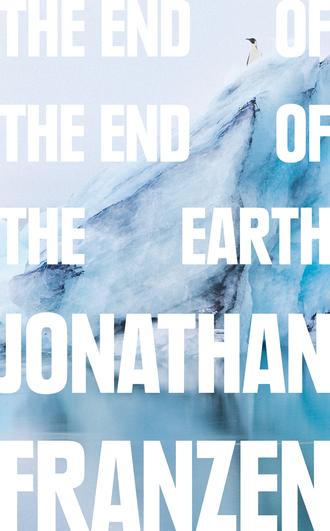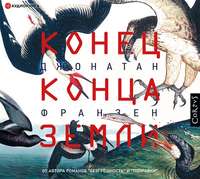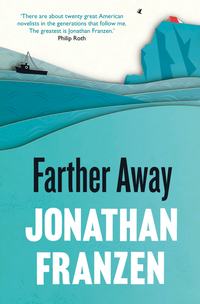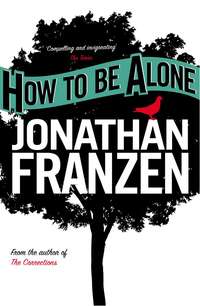
Полная версия
The End of the End of the Earth

Fifteen years later, after being married and divorced, I built a work studio in a loft on 125th Street, following Tom’s example and hanging my own drywall, wiring my own outlets. I’d gotten smarter about money, and I was able to jump on a cheap space in Harlem because I wasn’t scared of the city anymore. I had a personal connection with the Harlemites in my building, and after work I could go downtown and safely walk with my friends on the alphabet streets, which were being colonized by young white people. In time, on the strength of the sales of the book I’d written in Harlem, I bought my own Upper East Side co-op and became a person who took younger friends and relatives to dinner at places they couldn’t have afforded.
The city’s dividing line had become more permeable, at least in one direction. White power had reasserted itself through the pressure of real-estate prices and police action. In hindsight, the era of white fear seems most remarkable for having lasted as long as it did. Of all my mistakes as a twenty-one-year-old in the city, the one I now regret the most was my failure to imagine that the black New Yorkers I was afraid of might be even more afraid than I was.
On my last full day in Manhattan that summer, I got a check from Greg Heisler for my last four weeks of work. To cash it, I had to go to the European American Bank, a strange little hexagonal building that sat on a bite of dismal parkland taken out of SoHo’s southeast flank. I don’t remember how many hundred-dollar bills I was given there—maybe it was six, maybe nine—but it seemed to me a dangerous amount of cash to carry in my wallet. Before I left the bank, I discreetly slipped the bills into one of my socks. Outside, it was one of those bright August mornings when a cold front flushes the badness from the city’s sky. I headed straight to the nearest subway, anxious about my wealth, hoping I could pass as poor to someone who wanted the money in my sock more than I did.

If you could see every bird in the world, you’d see the whole world. Things with feathers can be found in every corner of every ocean and in land habitats so bleak that they’re habitats for nothing else. Gray Gulls raise their chicks in Chile’s Atacama Desert, one of the driest places on Earth. Emperor Penguins incubate their eggs in Antarctica in winter. Goshawks nest in the Berlin cemetery where Marlene Dietrich is buried, sparrows in Manhattan traffic lights, swifts in sea caves, vultures on Himalayan cliffs, chaffinches in Chernobyl. The only forms of life more widely distributed than birds are microscopic.
To survive in so many different habitats, the world’s ten thousand or so bird species have evolved into a spectacular diversity of forms. They range in size from the ostrich, which can reach nine feet in height and is widespread in Africa, to the aptly named Bee Hummingbird, found only in Cuba. Their bills can be massive (pelicans, toucans), tiny (Weebills), or as long as the rest of their body (Sword-billed Hummingbirds). Some birds—the Painted Bunting in Texas, Gould’s Sunbird in South Asia, the Rainbow Lorikeet in Australia—are gaudier than any flower. Others come in one of the nearly infinite shades of brown that tax the vocabulary of avian taxonomists: rufous, fulvous, ferruginous, bran-colored, foxy.
Birds are no less diverse behaviorally. Some are highly social, others anti. African queleas and flamingos gather in flocks of millions, and parakeets build whole parakeet cities out of sticks. Dippers walk alone and underwater, on the beds of mountain streams, and a Wandering Albatross may glide on its ten-foot wingspan five hundred miles away from any other albatrosses. New Zealand Fantails are friendly and may follow you on a trail. A caracara, if you stare at it too long, will swoop down and try to knock your head off. Roadrunners kill rattlesnakes for food by teaming up on them, one bird distracting the snake while another sneaks up behind it. Bee-eaters eat bees. Leaftossers toss leaves. The Oilbird, a unique nocturnal species of the American tropics, glides over avocado trees and snatches fruit on the fly; Snail Kites do the same thing, except with snails. Thick-billed Murres can dive underwater to a depth of 700 feet, Peregrine Falcons downward through the air at 240 miles an hour. A Wren-like Rushbird will spend its entire life beside one half-acre pond, while a Cerulean Warbler may migrate to Peru and then find its way back to the tree in New Jersey where it nested the year before.
Birds aren’t furry and cuddly, but in many respects they’re more similar to us than other mammals are. They build intricate homes and raise families in them. They take long winter vacations in warm places. Cockatoos are shrewd thinkers, solving puzzles that would challenge a chimpanzee, and crows like to play. (Check out the YouTube video of a crow in Russia sledding down a snowy roof on a plastic lid, flying back up with the lid in its beak, and sledding down again.) And then there are the songs with which birds, like us, fill the world. Nightingales trill in the suburbs of Europe, thrushes in downtown Quito, hwameis in Chengdu. Chickadees have a complex language for communicating, not only to one another but to every bird in their neighborhood, how safe or unsafe they feel from predators. Some lyrebirds in eastern Australia sing a tune their ancestors may have learned from a settler’s flute nearly a century ago. If you shoot too many pictures of a lyrebird, it will add the sound of your camera to its repertoire.
But birds also do the thing we all wish we could do but can’t, except in dreams: they fly. Eagles effortlessly ride thermals; hummingbirds pause in midair; quail burst into flight heart-stoppingly. Taken in sum, the flight paths of birds bind the planet together like a hundred billion filaments, tree to tree and continent to continent. There was never a time when the world seemed large to them. After breeding, a European swift will stay aloft for nearly a year, flying to sub-Saharan Africa and back, eating and molting and sleeping on the wing, without landing once. Young albatrosses spend as many as ten years roving the open ocean before they first return to land to breed. A Bar-tailed Godwit has been tracked flying nonstop from Alaska to New Zealand, 7,264 miles in nine days, while a Ruby-throated Hummingbird may burn up a third of its tiny body weight to cross the Gulf of Mexico. The Red Knot, a small shorebird species, makes annual round-trips between Tierra del Fuego and the Canadian Arctic; one long-lived individual, named B95 (for the tag on its leg), has flown more miles than separate the Earth and the moon.
There is, however, one critical ability that human beings have and birds do not: mastery of their environment. Birds can’t protect wetlands, can’t manage a fishery, can’t air-condition their nests. They have only the instincts and the physical abilities that evolution has bequeathed them. These have served them well for a very long time, 150 million years longer than human beings have been around. But now human beings are changing the planet—its surface, its climate, its oceans—too quickly for birds to adapt by evolving. Crows and gulls may thrive at our garbage dumps, blackbirds and cowbirds at our feedlots, robins and bulbuls in our city parks. But the future of most bird species depends on our commitment to preserving them. Are they valuable enough for us to make the effort?

Value, in the late Anthropocene, has come almost exclusively to mean economic value, utility to human beings. And, certainly, many wild birds are usefully edible. Some of them in turn eat noxious insects and rodents. Many others perform vital roles—pollinating plants, spreading seeds, serving as food for mammalian predators—in ecosystems whose continuing wildness has touristic or carbon-sequestering value. You may also hear it argued that bird populations function, like the proverbial coal-mine canary, as important indicators of ecological health. But do we really need the absence of birds to tell us when a marsh is severely polluted, a forest slashed and burned, or a fishery destroyed? The sad fact is that wild birds, in themselves, will never pull their weight in the human economy. They want to eat our blueberries.
What bird populations do usefully indicate the health of is our ethical values. One reason that wild birds matter—ought to matter—is that they are our last, best connection to a natural world that is otherwise receding. They’re the most vivid and widespread representatives of the Earth as it was before people arrived on it. They share descent with the largest animals ever to walk on land: the house finch outside your window is a tiny and beautifully adapted living dinosaur. A duck on your local pond looks and sounds very much like a duck twenty million years ago, in the Miocene epoch, when birds ruled the planet. In an ever more artificial world, where featherless drones fill the air and Angry Birds can be simulated on our phones, we may see no reasonable need to cherish and support the former rulers of the natural realm. But is economic calculation our highest standard? After Shakespeare’s King Lear steps down from the throne, he pleads with his elder two daughters to grant him some vestige of his former majesty. When the daughters reply that they don’t see the need for it, the old king bursts out: “O, reason not the need!” To consign birds to oblivion is to forget what we’re the children of.
A person who says, “It’s too bad about the birds, but human beings come first” is making one of two implicit claims. The person may mean that human beings are no better than any other animal—that our fundamentally self-centered selves, which are motivated by selfish genes, will always do whatever it takes to replicate our genes and maximize our pleasure, the nonhuman world be damned. This is the view of cynical realists, to whom a concern for other species is merely an annoying form of sentimentality. It’s a view that can’t be disproved, and it’s available to anyone who doesn’t mind admitting that he or she is hopelessly selfish.
But “human beings come first” may also have the opposite meaning: that our species is uniquely worthy of monopolizing the world’s resources because we are not like other animals; because we have consciousness and free will, the capacity to remember our pasts and shape our futures. This opposing view can be found among both religious believers and secular humanists, and it, too, is neither provably true nor provably false. But it does raise the question: if we’re incomparably more worthy than other animals, shouldn’t our ability to discern right from wrong, and to knowingly sacrifice some small fraction of our convenience for a larger good, make us more susceptible to the claims of nature, rather than less? Doesn’t a unique ability carry with it a unique responsibility?

If you stand in a forest in Southeast Asia, you may hear and then begin to feel, in your chest, a deep rhythmic whooshing. It sounds meteorological, but it’s the wingbeats of Great Hornbills flying in to land in a fruiting tree. They have massive yellow bills and hefty white thighs; they look like a cross between a toucan and a giant panda. As they clamber around in the tree, placidly eating fruit, you may find yourself crying out with the rarest of all emotions: pure joy. It has nothing to do with what you want or what you possess. It’s the sheer gorgeous fact of the Great Hornbill, which couldn’t care less about you.
The radical otherness of birds is integral to their beauty and their value. They are always among us but never of us. They’re the other world-dominating animals that evolution has produced, and their indifference to us ought to serve as a chastening reminder that we’re not the measure of all things. The stories we tell about the past and imagine for the future are mental constructions that birds can do without. Birds live squarely in the present. And at present, although our cats and our windows and our pesticides kill billions of them every year, and although some species, particularly on oceanic islands, have been lost forever, their world is still very much alive. In every corner of the globe, in nests as small as walnuts or as large as haystacks, chicks are pecking through their shells and into the light.

Last September, as someone who cares more about birds than the next man, I was following the story of the new stadium the Twin Cities are building for their football Vikings. The stadium’s glass walls were expected to kill thousands of birds every year, and local bird lovers had asked its sponsors to use a specially patterned glass to reduce collisions; the glass would have raised the stadium’s cost by one-tenth of one percent, and the sponsors had balked. Around the same time, the National Audubon Society issued a press release declaring climate change “the greatest threat” to American birds and warning that “nearly half” of North America’s bird species were at risk of losing their habitats by 2080. Audubon’s announcement was credulously retransmitted by national and local media, including the Minneapolis Star Tribune, whose blogger on bird-related subjects, Jim Williams, drew the inevitable inference: Why argue about stadium glass when the real threat to birds was climate change? In comparison, Williams said, a few thousand bird deaths would be “nothing.”
I was in Santa Cruz, California, and already not in a good mood. The day I saw the Williams quote was the two hundred and fifty-fourth of a year in which, so far, sixteen had qualified as rainy. To the injury of a brutal drought came the daily insult of radio forecasters describing the weather as beautiful. It wasn’t that I didn’t share Williams’s anxiety about the future. What upset me was how a dire prophecy like Audubon’s could lead to indifference toward birds in the present.
Maybe it’s because I was raised as a Protestant and became an environmentalist, but I’ve long been struck by the spiritual kinship of environmentalism and New England Puritanism. Both belief systems are haunted by the feeling that simply to be human is to be guilty. In the case of environmentalism, the feeling is grounded in scientific fact. Whether it’s prehistoric North Americans hunting the mastodon to extinction, Maori wiping out the megafauna of New Zealand, or modern civilization deforesting the planet and emptying the oceans, human beings are universal killers of the natural world. And now climate change has given us an eschatology for reckoning with our guilt: coming soon, some hellishly overheated tomorrow, is Judgment Day. Unless we repent and mend our ways, we’ll all be sinners in the hands of an angry Earth.
I’m still susceptible to this sort of puritanism. Rarely do I board an airplane or drive to the grocery store without considering my carbon footprint and feeling guilty about it.1 But when I started watching birds, and worrying about their welfare, I became attracted to a countervailing strain of Christianity, inspired by St. Francis of Assisi’s example of loving what’s concrete and vulnerable and right in front of us. I gave my support to the focused work of the American Bird Conservancy and local Audubon societies. Even the most ominously degraded landscape could make me happy if it had birds in it.
And so I came to feel miserably conflicted about climate change. I accepted its supremacy as the environmental issue of our time, but I felt bullied by its dominance. Not only did it make every grocery-store run a guilt trip; it made me feel selfish for caring more about birds in the present than about people in the future. What were the eagles and the condors killed by wind turbines compared with the impact of rising sea levels on poor nations? What were the endemic cloud-forest birds of the Andes compared with the atmospheric benefits of Andean hydroelectric projects?
A hundred years ago, the National Audubon Society was an activist organization, campaigning against wanton bird slaughter and the harvesting of herons for their feathers, but its spirit has since become gentler. In recent decades, it’s been better known for its holiday cards and its plush-toy cardinals and bluebirds, which sing when you squeeze them, than for generating hard science, taking controversial positions, or partnering with groups that do real conservation work. When the organization shifted into apocalypse mode, last September, I wished that it had stuck with plush toys. Love is a better motivator than guilt.
In rolling out its climate-change initiative, Audubon alluded to the “citizen science data” it had mobilized, and to a “report,” prepared by its own scientists, that justified its dire predictions. Visitors to its updated website were treated to images of climate-imperiled species, such as the Bald Eagle, and asked to “take the pledge” to help save them. The actions that Audubon suggested to pledge-takers were gentle stuff—tell your stories, create a bird-friendly yard—but the website also offered a “Climate Action Pledge,” which was long and detailed and included things like replacing your incandescent lightbulbs with lower-wattage alternatives.
The climate-change report was not immediately available, but from the website’s graphics, which included range maps of various bird species, it was possible to deduce that the report’s method involved a comparison of a species’ present range with its predicted range in a climate-altered future. When there was broad overlap between the two ranges, it was assumed that the species would survive. When there was little or no overlap, it was assumed that the species would be caught between an old range that had grown inhospitable to it and a new range in which the habitat was wrong, and would be at risk of disappearing.
This kind of modeling can be useful, but it’s fraught with uncertainties. A species may currently breed in a habitat with a particular average temperature, but this doesn’t mean that it couldn’t tolerate a higher temperature, or that it couldn’t adapt to a slightly different habitat farther north, or that the more northerly habitat won’t change as temperatures rise. North American species in general, having contended with blazing July days and frosty September nights as they evolved, are much more tolerant of temperature fluctuations than tropical species are. Although, in any given place, some familiar back-yard birds may have disappeared by 2080, species from farther south are likely to have moved in to take their place. North America’s birdlife may well become more diverse, not less.
The Bald Eagle was an especially odd choice of poster bird for Audubon’s initiative. The species nearly became extinct fifty years ago, before DDT was banned. The only reason we can worry about its future today is that the public—led by the then energetic Audubon—rallied around an immediate threat to it. The eagle’s plight was a primary impetus for the Endangered Species Act of 1973, and the eagle is one of the act’s great success stories. Once its eggs were no longer weakened by DDT, its population and range expanded so dramatically that it was removed from the endangered-species list in 2007. The eagle rebounded because it’s a resilient and resourceful bird, a generalist hunter and scavenger, capable of traveling long distances to colonize new territory. It’s hard to think of a species less liable to be trapped by geography. Even if global warming squeezes it entirely out of its current summer and winter ranges, the melting of ice in Alaska and Canada may actually result in a larger new range.
But climate change is seductive to organizations that want to be taken seriously. Besides being a ready-made meme, it’s usefully imponderable: while peer-reviewed scientific estimates put the annual American death toll of birds from collisions and from outdoor cats at more than three billion, no individual bird death can be definitively attributed to climate change, still less to any climate action that an ordinary citizen did or didn’t take. (Local and short-term weather patterns are the chaotic product of a host of variables, and whether one person drives a Hummer or a Prius has nothing to do with them.) Although you could demonstrably save the lives of the birds now colliding with your windows or being killed by your cats, reducing your carbon footprint even to zero saves nothing. Declaring climate change bad for birds is therefore the opposite of controversial. To demand stricter review of wind farms, to make sure they’re not built directly in the path of millions of migrating birds, would alienate environmental groups that favor wind power at any cost. To take an aggressive stand against the overharvesting of horseshoe crabs (the real reason that the Red Knot, a shorebird, had to be put on the list of threatened U.S. species this winter) might embarrass the Obama administration, whose director of the Fish and Wildlife Service, in announcing the listing, laid the blame for the Red Knot’s decline primarily on “climate change,” a politically more palatable culprit. Climate change is everyone’s fault—in other words, no one’s. We can all feel good about deploring it.
There’s no doubt that the coming century will be a tough one for wild animals. Even if climate scientists are wrong, and global temperatures miraculously stabilize tomorrow, we would still be facing the largest extinction event in sixty-five million years. What remains of the natural world is rapidly being destroyed by our rising population, by deforestation and intensive agriculture, by depletion of fisheries and aquifers, by pesticide and plastic pollution, and by the spread of invasive species. For countless species, including almost all of North America’s birds, climate change is a more distant and secondary threat. The responses of birds to acute climatic stress are not well studied, but birds have been adapting to such stresses for tens of millions of years, and they’re surprising us all the time—Emperor Penguins relocating their breeding grounds as the Antarctic ice melts, Tundra Swans leaving the water and learning to glean grains from agricultural fields. Not every species will manage to adapt. But the larger and healthier and more diverse our bird populations, the greater the chances that many species will survive, even thrive. To prevent extinctions in the future, it’s not enough to curb our carbon emissions. We also have to keep a whole lot of wild birds alive right now. We need to combat the extinctions that are threatened in the present, work to reduce the many hazards that are decimating North American bird populations, and invest in large-scale, intelligently conceived conservation efforts, particularly those designed to allow for climate change. These aren’t the only things that people who care about nature should be doing. But it only makes sense not to do them if the problem of global warming demands the full resources of every single nature-loving group.

A little tragicomedy of climate activism is its shifting of goalposts. Ten years ago, we were told that we had ten years to take the kind of drastic actions needed to prevent global temperatures from rising more than two degrees Celsius in this century. Today we hear, from some of the very same activists, that we still have ten years. In reality, our actions now would need to be even more drastic than they would have ten years ago, because further gigatons of carbon have accumulated in the atmosphere. At the rate we’re going, we’ll use up our entire emissions allowance for the century before we’re even halfway through it. Meanwhile, the actions that many governments now propose are less drastic than what they proposed ten years ago.









